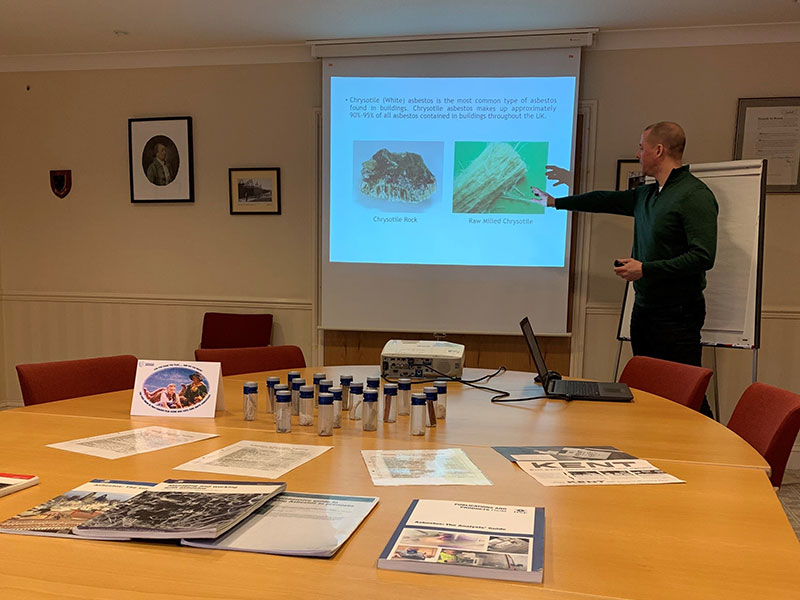Who should have asbestos training in schools?
The dangers of asbestos should be taken very seriously. Prolonged exposure to asbestos can result in major health conditions for decades into the future. Often, those conditions have no known cure and require aggressive treatments.
There are a lot of people going in and out of schools all day long. Students, staff, and visitors are all at risk if asbestos materials are present and they aren’t properly managed.
Luckily, it’s possible to avoid the risks of asbestos if you know what to do in an area that contains the materials. Asbestos training in schools gives workers the information they need to stay safe. While students themselves won’t receive training, those in charge of the classrooms and buildings will.

According to the Health and Safety Executive (HSE), it’s common for schools built before 2000 to contain some type of asbestos. The type of asbestos and where it’s found will vary. Asbestos materials in schools may include:
- Asbestos-insulating board
- Ceiling and floor tiles
- Cement roofing and gutters
- Textured coatings
- Thermal insulation on boilers, ducts, pipes, etc.
Asbestos-containing materials pose the greatest risk in schools if they’re damaged or disturbed. In most non-residential buildings, construction, maintenance, and repair teams are at the greatest risk. Those are the people who are working directly with or around asbestos.
Sometimes, though, asbestos is accidentally disturbed. That could pose a danger to anyone in the vicinity, including staff, students, and visitors. That’s why it’s important for educators and staff to know where asbestos may be present. For example, a teacher may know that the ceiling tiles in their room contain asbestos. They can prevent students from pinning materials to the ceiling.
Who is responsible for providing asbestos training to staff?
According to the Control of Asbestos Regulations 2012, the dutyholder of a building is responsible for training staff about how to handle asbestos on the premises. That person would most likely be responsible for the maintenance or repair of the school. For most schools, that means the employer, but the role of “employer” may vary based on the type of school.
For example, a nursery school’s employer may be the local authority. A schools employer may be the school governor. There are also times when the duty to manage asbestos in schools is shared by the local authority and the school.
It’s important to correctly determine who the dutyholder is. First, they are responsible for asbestos safety. Second, they may need more training in order to effectively carry out their responsibilities.
What does the duty to manage asbestos involve?
Dutyholders are responsible for the following:
- Knowing if and where the property contains asbestos
- Knowing the condition of the asbestos
- Assessing and managing asbestos risk to children, employees and anyone who could be affected
- Maintaining a record of the asbestos that’s regularly updated
- Providing information about the asbestos to anyone who might work near it
- Ensuring that workers who may disturb the asbestos are trained
This can be a lot to manage. That’s why there are training courses dedicated to helping dutyholders learn what’s expected of them. We’ll talk about that a bit more later.
Who is required to take asbestos awareness training?
Anyone who could disturb asbestos during their regular work day must be trained. Additionally, anyone who supervises employees must receive asbestos awareness training. The dutyholder must make sure that those people get the correct information, instruction, and training so they can safely work on the premises.
How often should asbestos awareness training be carried out?
According to the HSE, instruction, training, and refresher information must be provided once per year. It can be offered more frequently if needed. There are a few scenarios that may require more frequent training:
- The equipment used to control asbestos exposure changes.
- There’s a change to work methods or the type of work taking place.
- Workers have competency gaps and require additional training.
Refresher courses go over the basic elements of the full training course. However, it’s fine to take extra time to cover topics more in-depth as needed.
What types of asbestos training are suitable for schools?
Asbestos information, instruction, and training should be personalised to the individual receiving it. According to the HSE, it should be “appropriate for the work and the roles undertaken by each worker (and supervisor).”
That means that a teacher won’t necessarily need to know how to safely remove asbestos. That type of training is for the people who will actually be handling building renovations. However, the teacher may need to know how to recognise asbestos and what not to do so as not to disturb it.
A training needs analysis (TNA) can identify the topics to be covered for each worker. That way, they’ll receive the right amount of education for their role at the school.
What should asbestos awareness training cover?
It’s important to understand what asbestos awareness does and does not cover:
- Asbestos awareness does provide information about avoiding work that could disturb asbestos.
- Asbestos awareness does not provide information about how to work with asbestos materials.
Workers who will be dealing directly with asbestos require a different type of training. Asbestos awareness should cover the following topics:
- How asbestos impacts health
- The types of asbestos materials in the school
- How to avoid being exposed to asbestos
- Emergency procedures for dealing with disturbed asbestos
Today, it’s common for asbestos awareness training to take place online. Note that it must satisfy certain requirements — Regulation 10 from the Control of Asbestos Regulations 2012 and the Code of Practice L143.
Cat A: Asbestos Awareness Training and Refresher
Cat A is the most basic type of asbestos training you can get. It’s also where schools should begin if they need an introduction to asbestos awareness. For many workers, asbestos training beyond Cat A won’t be necessary. In general, Cat A training explains the potential risks that asbestos presents.
It’s best if the Cat A training you opt for is approved by the United Kingdom Asbestos Training Association (UKATA). UKATA is a leading association dedicated to improving the quality and standards of asbestos training, with the ultimate goal of protecting workers and the public from the risks associated with asbestos exposure.
We have Cat A training at Oracle Solutions. This is the best option for people who will not be disturbing or removing asbestos but who work in a building where asbestos materials are present. It’s also the minimum training needed for managers or supervisors of workers who will be disturbing or removing asbestos materials.
The training course goes over everything needed for asbestos awareness. The refresher course provides a recap of the full course. Where needed, extra attention to certain aspects of asbestos awareness will be given.
How long is Cat A training?
Our Cat A Asbestos Awareness training takes about 4 to 5 hours to complete. Our Cat A Asbestos Awareness Refresher takes about 2 hours to complete.
How often do I need Cat A training?
Asbestos awareness training must be updated at least every 12 months.
Duty to Manage training
For dutyholders who are unsure what’s expected of them in terms of asbestos safety, the Duty to Manage training course can help. You’ll learn about your legal responsibilities for managing asbestos, including:
- Creating an asbestos management plan
- Deciding on your asbestos action plan
- Assessing the risk of asbestos on the premises
- Managing the asbestos risk on the premises
This course is intended for dutyholders. However, it could also be helpful for anyone involved with managing a building or who has involvement with asbestos materials in the building.
Our Duty to Manage program has three training courses to choose from:
- Course 1: Initial training for those who haven’t taken any UKATA-approved training. This course takes a minimum of 6 hours to complete.
- Course 2: This is for those who have had UKATA-approved training within the last six months. This training takes about 3 hours to complete.
- Course 3: This is a refresher course for anyone who has completed either course 1 or 2 within the past year. This course will take a maximum of 3 hours to complete.
This isn’t a legally mandatory course. But it can be helpful for first-time dutyholders or dutyholders who aren’t well-versed in asbestos management.
Final thoughts
Schools (and non-residential buildings in general) that were built prior to 2000 are likely to include asbestos-containing materials. Anyone who is in the school on a regular basis for work should know about the risks of asbestos and how to avoid them.
The dutyholder is responsible for providing adequate training to employees. Cat A training is the most basic type of asbestos awareness training that most teachers and staff members will need, and it’s best if that training is approved by UKATA.
Contact Oracle Solutions today to learn more about our UKATA-approved asbestos awareness courses. We also provide virtual online training as well.

Written by Brendan Coleman
Brendan Coleman, with decades of experience in the asbestos industry, is a dedicated Quality Manager. Certified as a surveyor and analyst, he is adept in operations and quality management with a keen focus on HSE compliance. His expertise is pivotal in maintaining high safety and efficiency standards. Brendan ensures our UKAS accreditation requirements are consistently met and exceeded, upholding stringent standards in asbestos remediation. His commitment to enhancing quality and customer satisfaction makes him an essential advisor in asbestos management.
